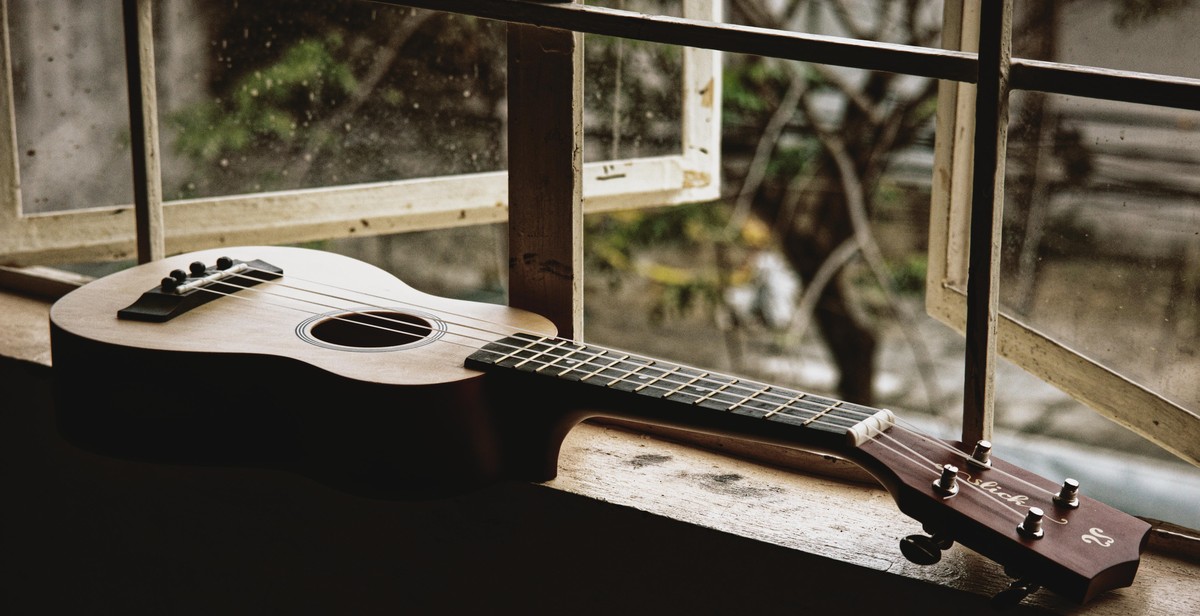How to Play the Ukulele: Beginner’s Guide to Chords and Strumming
Are you looking for a fun and easy musical instrument to learn? Look no further than the ukulele! The ukulele is a small, four-stringed instrument that originated in Hawaii in the late 19th century. It has since gained popularity around the world, thanks in part to its charming sound and portability.
What is a Ukulele?
The ukulele is similar in size and shape to a guitar, but it has a distinct sound and playing style. The four strings are typically tuned to the notes G, C, E, and A, and the instrument is played by strumming or picking the strings with the fingers or a pick.
There are several types of ukuleles, including soprano, concert, tenor, and baritone. The soprano is the smallest and most common type, while the baritone is the largest and has a deeper sound.
Why Learn to Play the Ukulele?
There are many reasons to learn to play the ukulele, including:
- It’s easy to learn: Unlike many other instruments, the ukulele has a relatively simple playing style and can be picked up quickly by beginners.
- It’s affordable: Ukuleles are generally less expensive than other instruments, making them a great option for those on a budget.
- It’s portable: The ukulele is small and lightweight, making it easy to take with you wherever you go.
- It’s fun: The ukulele has a cheerful and upbeat sound that is sure to put a smile on your face.
Whether you’re looking to start a new hobby, impress your friends with your musical skills, or simply have some fun, learning to play the ukulele is a great choice. In this beginner’s guide, we’ll show you everything you need to know to get started, from basic chords to strumming techniques.

Choosing the Right Ukulele
When it comes to learning how to play the ukulele, choosing the right instrument is crucial. There are different types and sizes of ukuleles, each with its own unique sound and characteristics. Here are some factors to consider when choosing the right ukulele for you:
Types of Ukuleles
There are four main types of ukuleles: soprano, concert, tenor, and baritone. The soprano ukulele is the smallest and most traditional type, with a bright and high-pitched sound. The concert ukulele is slightly larger and has a fuller sound. The tenor ukulele is even larger and has a deeper, richer tone. The baritone ukulele is the largest and produces a sound similar to that of a classical guitar.
Consider the type of music you want to play and the sound you prefer when choosing a ukulele. Soprano ukuleles are great for traditional Hawaiian music and folk songs, while tenor and baritone ukuleles are better suited for playing jazz and blues.
Sizes of Ukuleles
Ukuleles come in four different sizes: soprano, concert, tenor, and baritone. The size of the ukulele affects its sound and playability. Smaller ukuleles like the soprano are easier to play and great for beginners, while larger ukuleles like the baritone are better suited for experienced players.
| Ukulele Size | Length | Tuning |
|---|---|---|
| Soprano | 20 inches | GCEA |
| Concert | 23 inches | GCEA |
| Tenor | 26 inches | GCEA or DGBE |
| Baritone | 30 inches | DGBE |
Consider your hand size and playing style when choosing the size of your ukulele. A larger ukulele may be more comfortable for those with larger hands, while a smaller ukulele may be easier to play for those with smaller hands.
Accessories to Consider
When choosing a ukulele, there are also some accessories to consider. A case or gig bag can help protect your ukulele when not in use. A tuner is essential for keeping your ukulele in tune, and a strap can make it easier to play while standing up.
- Case or gig bag
- Tuner
- Strap
Consider what accessories you may need based on your playing style and needs.

Basic Chords
As a beginner in ukulele playing, it is essential to learn the basic chords. In this section, we will discuss the four basic chords, namely C Major, A Minor, F Major, and G Major.
C Major
The C Major chord is one of the most commonly used chords in ukulele playing. To play this chord, place your ring finger on the third fret of the A string, your middle finger on the second fret of the G string, and your index finger on the first fret of the E string. Strum all four strings to produce a clear and crisp sound.
A Minor
The A Minor chord is another basic chord that is easy to play. To play this chord, place your middle finger on the second fret of the G string, and your index finger on the second fret of the C string. Strum all four strings to produce a soft and mellow sound.
F Major
The F Major chord may be a bit challenging for beginners, but with practice, it can be mastered. To play this chord, place your index finger on the first fret of the E string, your middle finger on the second fret of the G string, and your ring finger on the third fret of the C string. Strum the top three strings to produce a bright and clear sound.
G Major
The G Major chord is another commonly used chord in ukulele playing. To play this chord, place your index finger on the second fret of the C string, your middle finger on the second fret of the A string, and your ring finger on the third fret of the E string. Strum all four strings to produce a warm and bright sound.
Learning these basic chords is essential as they are the foundation of most songs. It is important to practice playing these chords until you can produce a clear sound. With continuous practice, you will be able to learn more complex chords and play your favorite songs on the ukulele.

Strumming Patterns
Strumming is an essential part of playing the ukulele. It is the rhythmic movement of the hand over the strings of the ukulele, producing sound. There are different strumming patterns that you can use to create different rhythms and styles of music. In this section, we will discuss the basic strumming patterns that every beginner should know.
Down Strums
The down strum is the most basic strumming pattern. It involves strumming the strings in a downward motion using your dominant hand. To play a down strum, hold your ukulele in the playing position and rest your dominant hand on the strings. Then, using your wrist, bring your hand down over the strings, striking them with the pads of your fingers. Repeat this motion in a steady rhythm to create a simple and consistent sound.
Up Strums
The up strum is the opposite of the down strum. It involves strumming the strings in an upward motion using your dominant hand. To play an up strum, hold your ukulele in the playing position and rest your dominant hand on the strings. Then, using your wrist, bring your hand up over the strings, striking them with the pads of your fingers. Repeat this motion in a steady rhythm to create a different sound from the down strum.
Combining Strums and Chords
Once you have mastered the down and up strums individually, you can start combining them to create more complex strumming patterns. You can also start incorporating chords into your strumming patterns to create different sounds and styles of music. To do this, start by playing a down strum on the first beat of the measure, followed by an up strum on the second beat. Then, switch to a different chord and repeat the pattern. As you become more comfortable, you can experiment with different strumming patterns and chord progressions to create your own unique sound.
| Chord | Strumming Pattern |
|---|---|
| C | Down, down, up, up, down, up |
| G | Down, up, down, up, down, up |
| F | Down, down, up, up, down, up |
Remember, practice makes perfect. Keep practicing these basic strumming patterns and chord progressions until you feel comfortable and confident. Then, start experimenting with different patterns and progressions to create your own unique sound.

Playing Songs
Learning to play songs is one of the most enjoyable aspects of playing the ukulele. Here are some easy songs to learn as a beginner:
- Twinkle, Twinkle Little Star: This classic children’s song can be played with just two chords, C and F.
- Amazing Grace: This traditional hymn can be played with the chords C, F, and G7.
- Happy Birthday: This timeless tune can be played with the chords C, F, and G7 or C, G, and F.
- Blowin’ in the Wind: This Bob Dylan classic can be played with the chords C, F, and G7.
When learning songs, it’s important to start with simple ones and gradually work your way up to more complex songs. Here are some tips for learning songs:
Tips for Learning Songs
- Start with Easy Songs: As mentioned earlier, start with easy songs that only require a few chords.
- Practice Chord Transitions: Practice switching between chords smoothly and quickly. This will make playing songs easier and more enjoyable.
- Sing Along: Singing along with the song can help you keep the rhythm and timing of the chords.
- Use a Metronome: A metronome can help you keep a steady beat while playing songs.
- Slow it Down: If a song is too fast, slow it down and gradually increase the speed as you become more comfortable with the chords.
Lastly, finding songs to play can be a challenge for beginners. Here are some resources for finding songs:
Resources for Finding Songs
| Website | Description |
| Ukulele Tabs | A website with a large collection of ukulele tabs and chords for a variety of songs. |
| Ultimate Guitar | A website with tabs and chords for guitar and ukulele songs, as well as user-submitted reviews and ratings. |
| Songsterr | A website with tabs and chords for guitar and ukulele songs, as well as a playback feature that allows you to hear the music while following along with the tabs. |

Practice Tips for Learning the Ukulele
Learning how to play the ukulele can be an enjoyable and rewarding experience. However, it requires dedication and consistent practice to make progress. Here are some practice tips to help you establish a routine, stay motivated and track your progress.
Establishing a Practice Routine
Creating a practice routine is essential for making progress. Decide on a specific time and place to practice daily. Whether it’s early in the morning or before bed, consistency is key. Start with short practice sessions of 10-15 minutes and gradually increase the time as you progress.
- Set achievable goals for each practice session
- Warm-up with simple exercises before playing chords and strumming
- Focus on one technique or song at a time
Staying Motivated
Learning any new skill can be frustrating at times. Staying motivated is crucial for sticking with it. Here are some ways to keep yourself motivated:
- Listen to music and watch videos of ukulele players you admire
- Join a ukulele group or find a practice partner
- Reward yourself after achieving a goal
Tracking Progress
Tracking your progress is important for staying motivated and seeing your improvement over time. Here are some ways to track your progress:
| Method | Description |
|---|---|
| Record yourself playing | Listen back to your recordings to hear your improvement |
| Keep a practice journal | Write down what you practiced and what you achieved |
| Use a metronome | Track your progress by gradually increasing your speed |
By following these practice tips, you’ll be well on your way to mastering the ukulele.
